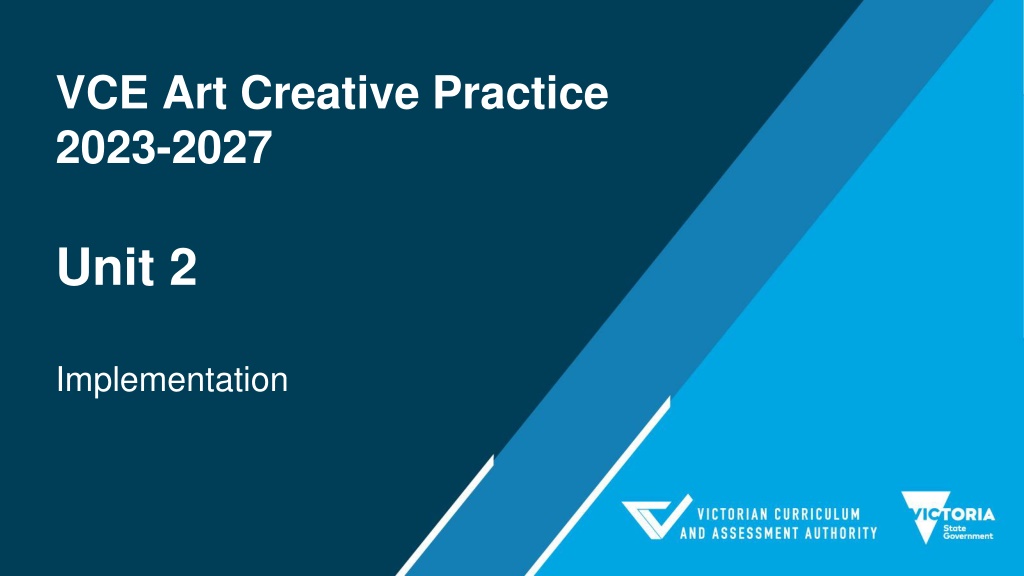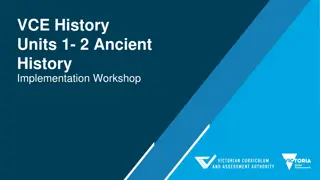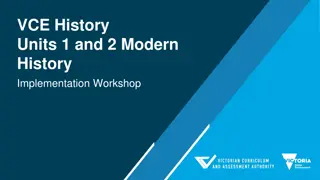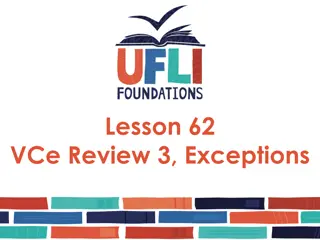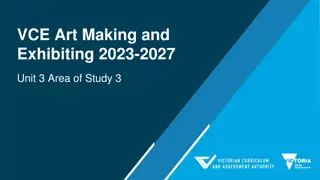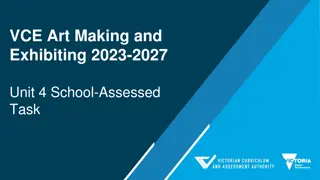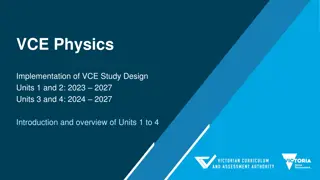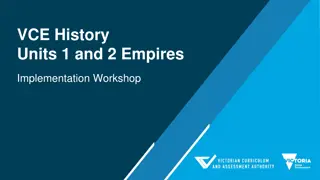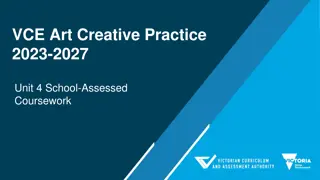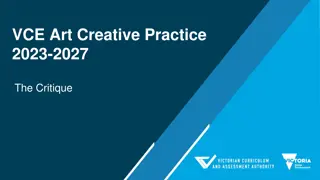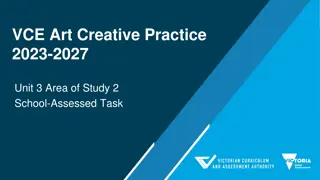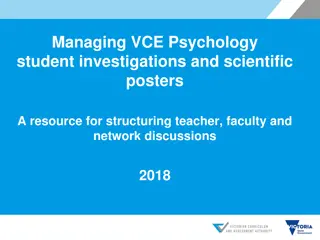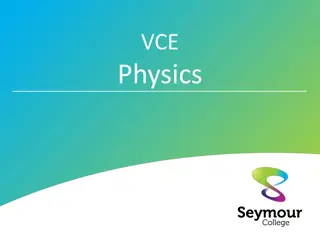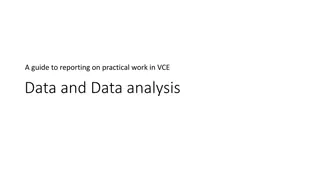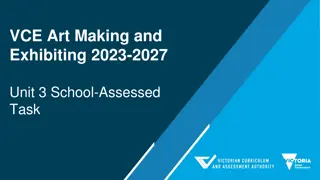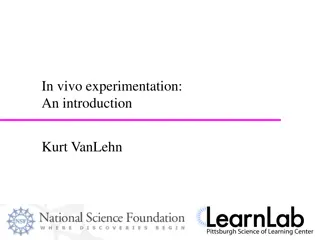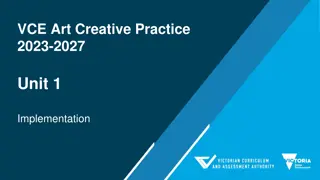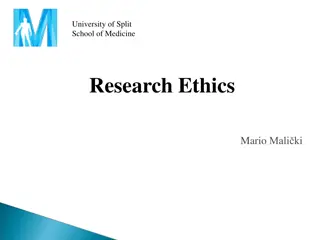Exploring VCE Art Creative Practice: Research, Experimentation, and Development
Delve into the components of VCE Art Creative Practice including research, exploration of ideas and influences, experimentation with materials and techniques, and development of artworks. Discover how artists creatively express personal, cultural, and social influences through visual language and interpretation in various contexts.
Download Presentation

Please find below an Image/Link to download the presentation.
The content on the website is provided AS IS for your information and personal use only. It may not be sold, licensed, or shared on other websites without obtaining consent from the author. Download presentation by click this link. If you encounter any issues during the download, it is possible that the publisher has removed the file from their server.
E N D
Presentation Transcript
VCE Art Creative Practice 2023-2027 Unit 2 Implementation
VCE Art Creative Practice Unit 2 Outline Features of Unit 2 VCE Art Creative Practice Overview of the areas of study Teaching ideas Assessment ideas
VCE Art Creative Practice: Study specifications Inquiry learning Experiential learning Project based learning
VCE Art Creative Practice Study specifications: The Creative Practice research and investigation experimentation and development refinement and resolution reflection and evaluation. Inquiry learning Experiential learning Project based learning
The Creative Practice Research and exploration The research and exploration component of the Creative Practice includes: researching and exploring ideas based on experiences, observations and personal interest researching and exploring materials, techniques and processes in art forms to respond to personal, cultural and social influences and ideas researching and examining personal, cultural, historical and social influences that inform the exploration and development of artworks exploring, analysing and interpreting influences and ideas in artworks using the Interpretive Lenses exploring, analysing and evaluating how artists use visual language to communicate personal, cultural and social influences, ideas, beliefs and values.
The Creative Practice Experimentation and development The experimentation and development component of the Creative Practice includes: experimenting with materials, techniques and processes to develop artworks experimenting with personal ideas and responses experimenting with the influences of ideas, values and beliefs to develop artworks developing ideas in artworks through experimentation and exploration developing knowledge of art elements and art principles through experimentation and exploration to create visual language developing points of view and interpretations of the meanings and messages of artworks in different contexts using the Interpretive Lenses developing artworks in response to the research and exploration of and experimentation with visual language.
The Creative Practice Reflection and evaluation The reflection and evaluation component of the Creative Practice includes: analysing and evaluating artworks using the appropriate Interpretive Lenses analysing and evaluating the application of materials, techniques and processes to resolve ideas in artworks using the Interpretive Lenses critically analysing and evaluating how the symbolic values and beliefs of people, places and objects are assigned by artists and viewers or audiences analysing and evaluating how visual language can communicate ideas and meaning in artworks reflecting, analysing and evaluating using critique and feedback.
The Creative Practice Refinement and resolution resolving ideas and visual language in artworks resolving points of view and interpretations of the meanings and messages of artworks, using critical judgment and the Interpretive Lenses realising and refining artworks through the selection and manipulation of materials, techniques and processes refining the use of visual language to communicate ideas and meaning in artworks refining technical skill in the use of materials, techniques and processes in art forms to communicate ideas and meaning in artworks considering the presentation and display of artworks in different contexts to communicate ideas and meaning.
VCE Art Creative Practice Study specifications: Interpretive Lenses Through Making and Responding The Structural Lens informs the analysis and interpretation of an artwork, and its relationship with the artist and viewer or audience, through the investigation of the use of art elements and art principles, and the application of materials, techniques and processes. It also considers the stylistic qualities and symbolism evident in the artwork, and the context in which artists work and in which artworks are presented or viewed. Structural Lens The Personal Lens informs the analysis and interpretation of an artwork through the investigation of the personal feelings, beliefs and life experiences of the artist, viewer or audience. Personal Lens The Cultural Lens informs the analysis and interpretation of an artwork through the investigation of social, historical and cultural influences and representations. Cultural Lens
VCE Art Creative Practice Study specifications: Study Terms Art elements Art principles Art forms Contexts Critique Influences and inspiration Visual language Body of Work Contemporary artists and artworks
VCE Art Creative Practice Big Planning Ideas Inspiration A core focus of VCE Art Creative Practice is the place of the student artist in the world continuum of artmaking. The connection of the student to historical and contemporary art is crucial and students must be supported to regularly refer to the work of other artists and sources of inspiration. Selecting artworks for study Students should be encouraged to view artworks from a broad range of periods and cultures and experiment with a wide range of materials, techniques and processes. The study encourages teachers to take their students out of the classroom environment and inform their art making through visits to galleries and studios, and through experience working with practising artists, curators, critics and art historians.
VCE Art Creative Practice Big planning ideas Selecting artists for study Select artists for whom there is sufficient background information, so the inquiry can be deep and broad. Investigate the origins of the artist s practice more broadly and research the ideas and issues they represent in their work. Investigate the intention of the artist for the presentation of the work and for whom it is intended and why.
VCE Art Creative Practice Big planning ideas Art Forms VCE Art Creative Practice introduces students to a range of artists practice and artworks. It is important that in students engage with a range of art forms across Units 1 to 4. A list of art forms is on page 17 of the VCE Art Creative Practice study design along with a definition of materials, techniques and processes. Students must understand the specific use of materials, techniques and processes associated with the art form that is selected. Teachers should aim to expose students to a diverse range of art forms and how visual language is created by artists working in a specific art form.
VCE Art Creative Practice Big planning ideas In Unit 2 Area of Study 1 students select three artists to research from different periods of time and cultures including contemporary artists and Aboriginal and Torres Strait Islander artists. The selection of these artists for study could inform the artforms the students explore in collaborative practice in Unit 2 Area of Study 2. In Unit 2 Area of Study 2 students study approaches to collaborative practice. Students work should work in an art form that encourages collaboration such as contemporary art practice. Contemporary art practice is often conceptual so students may be research art forms that are multidisciplinary.
VCE Art Creative Practice The Visual diary A visual diary is used to record and document making and responding in Creative Practice. Students should be encouraged to use formats that suit their working method and the body of work that they are producing. Visual Arts diary form document boxes Sketchbooks bound or clipped together sheets, or portfolios digital formats for their visual diary such as an online repository. Visual Arts diary content Annotations Visual material Audio recordings Documentation that is numbered and dated
VCE Art Creative Practice Unit 2: Interpreting artworks and developing the Creative Practice Inquiry learning Explore collaborative practice, historical and contemporary contexts Visual responses exploring collaborative practice, historical and contemporary contexts Use of the Creative Practice and collaboration to make and present artworks Understand the Cultural Lens Area of Study Outcome On completion of this unit the student should be able to use the Cultural Lens, and the other Interpretive Lenses as appropriate, to analyse and compare the practices of artists and artworks from different cultures and times. Area of Study 1 The artist, society and culture On completion of this unit the student should be able to use the Creative Practice to explore social and cultural ideas or issues to make and present at least one finished artwork using collaborative approaches. Area of Study 2 The collaborative Creative Practice On completion of this unit the student should be able to critically reflect on, evaluate and document their use of the Creative Practice to develop and make collaborative visual responses. Area of Study 3 Documentation of collaboration using the Creative Practice
VCE Art Creative Practice Unit 2 Area of Study 1: The artist, society and culture On completion of this unit the student should be able to use the Cultural Lens, and the other Interpretive Lenses as appropriate, to analyse and compare the practices of artists and artworks from different cultures and times. Outcome 1 Guiding questions What is the role and purpose of art in societies? How do artworks reflect cultural and personal values and beliefs? What is collaborative artistic practice? How do contemporary artists represent ideas in their work? What are the differences between contemporary and historical art practice? What components of the Creative Practice do I use in my investigation? What aspects of the Cultural Lens will I use to analyse and interpret artworks? What artists will I investigate? (Refer to the list of artists on page 23 of the Art Creative Practice study design) Learning structure
VCE Art Creative Practice Unit 2 Area of Study 1: The artist, society and culture Key knowledge the use of relevant aspects of the Cultural Lens to analyse and interpret artworks the use, as appropriate, of relevant aspects of the Structural Lens and the Personal Lens to analyse and interpret artworks diverse and alternative approaches to making and presenting artworks methods of making and presenting artworks in different historical and contemporary cultural contexts how artworks reflect the beliefs, values and traditions of different cultures the different ways that artists collaborate to make artworks the practices of artists from different periods of time and cultures referencing to support the analysis, evaluation and interpretation of artworks art terminology used in the analysis, evaluation and comparison of artworks and the practices of artists the role and purpose of art in different cultural contexts and times
VCE Art Creative Practice Unit 2 Area of Study 1: Artists, artworks and audiences Key skills cultures and times apply, as appropriate, relevant aspects of the Structural Lens and the Personal Lens to analyse and interpret artworks compare artworks from different cultural and historical contexts analyse diverse and alternative approaches to making and presenting artworks analyse methods of making and presenting artworks in historical and contemporary cultural contexts analyse how artworks can reflect the beliefs, values and traditions of different cultures investigate the different ways that artists collaborate to make artworks evaluate and compare the practices of artists from different periods of time and cultures use references to artworks to support analysis, evaluation and interpretation use appropriate art terminology to analyse, evaluate and compare the practices of artists and artworks apply the Cultural Lens to analyse and interpret artworks from different
VCE Art Creative Practice Unit 2 Area of Study 1 Inquiry learning activities In Unit 2 Area of Study 1 students investigate the context of artworks and how values, beliefs and traditions of societies are reflected in artworks. The inquiry can be also structured on a question that links the artists that are selected from the list on page 23 of the study design. The focus is on the artists use of materials, techniques and processes. The focus in this Area of Study is on how artists collaborate with each other. Students could use the concept of collaboration as the focus for their inquiry. They could use critical and creative thinking to investigate the relationships the artists have in their practice and how viewpoints and ideas, that are often disparate, are combined in to make artworks. Students are also required to investigate the making and presentation of artworks so they can conduct an open ended inquiry using the artwork as a starting point. They can investigate the relationships between the context of the work (where it was made and produced) and where it is viewed. The context may have an influence over how the work is interpreted and the direction of the inquiry the student will undertake.
VCE Art Creative Practice Unit 2 Area of Study 1 Teaching and Learning Ideas Students use the Cultural lens and compare artists practices, meanings and messages. Create a mind map on My Culture including technology, leisure, food, celebration, sport or religion. Influence of artistic collaborations impact on other artists. o Technical assistants collaborating with artists Cindy Sherman and Patricia Piccinini o Cahun and Moore s collaborations Claude Cahun and Marcel Moore Comparison of the practices of May Morris, Sally Smart and Yinka Shonibare who collaborate with craftspeople to realise their ideas. Theme: Football. Artists Vincent Namatjira, Pitcha Making Fellas and the Hermannsburg potters, all of whom are Aboriginal and Torres Strait Islander artists and work with Australian Rules Football.
VCE Art Creative Practice Unit 2 Area of Study 1 Detailed learning example 1 Scaffold - Collect artists information - Make dot points for description and comparison of artworks, materials, methods/collaboration. - Make dot points using the Interpretive Lenses questions - Create and present response Interpretive Lenses Questions - How has each artist used their artworks as a vehicle to invite change and provoke conversation? - How has each artist worked in collaboration? Do they work specifically with someone? How? - How do each artists methods differ? Is the era relevant to the way they work? - What is significant culturally to the way the artist works?
VCE Art Creative Practice Unit 2 Area of Study 1 Detailed learning example 1 May Morris 1862 1938. English. - Technique/Medium: Fabric - Subject matter: English Flora - Practice: Textile and embroidery - Collaboration: Artisans, Morris & Co, England Yinka Shonibare 1962 - British Nigerian. - Technique/Medium: Mixed media, fabric installations - Collaboration: Artisan, Fabric Workshop and Museum, Philadelphia (FWM), USA - Subject matter: Cultural identity, colonialism, post colonialism Sally Smart 1960 Australian. - Fashion House - Marni, Italy - Subject matter: Identity, gender politics - Practice: Large scale assemblage installation with performance and video - Collaboration: Artisans, Dancers, filmakers - Practice: Large scale mixed media installations
VCE Art Creative Practice Unit 2 Area of Study 1 Detailed learning example 2 Analyse and compare how the lives of Aboriginal and Torres Strait Islander peoples are reflected in the work of Albert Namatjira, Emily Kgnwarreye and Joan Ross. Albert Namatjira 1902 1959 Australia Watercolour. Australian landscapes in a western style connection to the land Emily Kgnwarreye 1910 1996 Australian Paintings and textiles. Traditional dreaming stories Joan Ross (Date of Birth unknown) Scottish/Australian Multimedia artist, assemblage and video. Colonialism in Australia, particularly its effect on indigenous Australians
VCE Art Creative Practice Unit 2 Area of Study 1 Assessment .On completion of this unit the student should be able to use the Cultural Lens, and the other Interpretive Lenses as appropriate, to analyse and compare the practices of artists and artworks from different cultures and times. Examples such as: an extended written response short-answer responses supported by visual references an annotated visual report a presentation using digital technologies such as an online presentation or interactive website an oral presentation The three artists selected for study must include: an Aboriginal or Torres Strait Islander person an artist who collaborates with other artists, technicians or with the viewer or audience as part of their practice an artist from a historical period of time that has used at least one traditional art form and traditional materials and techniques a contemporary artist whose practice is influenced by contemporary ideas, materials, techniques, processes or approaches.
VCE Art Creative Practice Unit 2 Area of Study 1 Assessment Example Table to scaffold task Materials, Techniques and Processes Signs and Symbols Meanings and messages Artist 1 Artist 2 Artist 3 Similarities Differences
VCE Art Creative Practice Unit 2 Area of Study 1 Assessment Example Structural Lens Compare the materials, techniques and processes used by the artist(s). Do they vary, according to the time and place that they were used? Are there similarities or differences between the aesthetics of the works? Discuss. Do the artists use symbols to communicate? How? Are there similarities or differences in the ways the artists do this?
VCE Art Creative Practice Unit 2 Area of Study 1 Assessment Example Personal Lens Are there similarities between the lives of the artists? Is this reflected in their work? How? Did the artist(s) work in isolation, or collaboratively? How has this influenced the work? Does the artist(s) have specific beliefs that are relevant to the work? Have the life experiences of the artist(s) influenced the work? How? Do the specific beliefs of the audience affect their response to the works? How? How would a contemporary audience have responded to each of the works? How do you (the student) respond to each of the works? Are you drawn to one more than the others? Why?
VCE Art Creative Practice Unit 2 Area of Study 1 Assessment Example Cultural Lens How have the time periods in which the artists worked influenced them? How is this evident? Does a contemporary audience interpret the works differently to the original audience? Why? Do the artists make work that responds to political events? How is this evident? Do the artists subscribe to spiritual or philosophical ethos ? How is this explored in their work? Have economics influenced the artists? Did their socio-economic situation influence their subject matter? Did they have access to materials, or have they used found or repurposed materials? Has the work of the artists changed in financial value? How does this affect the interpretation of the work? Does the ethnic background of the artists bring art practices and visual elements to the works? Is the gender of the artists reflected in their work? How? Do the artists ask their audiences to consider ethical issues? Do the practices of the artists provoke shock or disgust? Why? How do these factors contribute to engagement and communication of meaning?
VCE Art Creative Practice Unit 2 Area of Study 2: The collaborative Creative Practice On completion of this unit the student should be able to use the Creative Practice to explore social and cultural ideas or issues to make and present at least one finished artwork using collaborative approaches. Outcome 2 Guiding questions Learning structure How are collaborative artworks developed? What are the processes used to make collaborative artworks? How do artists develop visual language in collaborative practice? How has collaborative practice changed over time? What are the differences in collaborative practice from different periods of time? Is collaborative practice different in other cultures? What are the characteristics that reflect the culture? How will I use collaborative practice to develop artworks? What is my role in the collaborative process? How will I use different traditional and contemporary materials, techniques and processes to communicate ideas and meaning in my collaborative artworks What components of the Creative Practice will I use to explore social and cultural ideas or issues in artworks? What aspects of the Cultural lens and other interpretive lenses will I use in my Creative Practice?
VCE Art Creative Practice Unit 2 Area of Study 2: The collaborative Creative Practice Key knowledge the use of the Creative Practice to explore social and cultural ideas or issues the use of the Creative Practice to make and present at least one finished artwork collaborative approaches in art practices from different periods of time and cultures the use of visual language to communicate ideas and issues of social and cultural interest in visual responses the use of the Cultural Lens, and the other Interpretive Lenses as appropriate, throughout the Creative Practice the use of traditional and contemporary materials, techniques and processes in art forms to communicate ideas and meaning
VCE Art Creative Practice Unit 2 Area of Study 2: The Collaborative Creative Practice Key skills explore social and cultural ideas or issues using the Creative Practice make and present at least one finished artwork using the Creative Practice reflect on the collaborative practices of artists from different periods of time and cultures throughout the Creative Practice explore collaborative approaches to make and present artworks develop visual language to communicate ideas and issues of social and cultural interest in visual responses use the Cultural Lens, and the other Interpretive Lenses as appropriate, throughout the Creative Practice explore and experiment with traditional and contemporary materials, techniques and processes in art forms to communicate ideas and meaning
VCE Art Creative Practice Unit 2 Area of Study 2 Inquiry learning activities . Students could select a idea or issue to explore using the Creative Practice and collaboration. A leading question could be the focus for the exploration. The question could come from the investigation the students conduct into collaborative practice. Artists researched in Area of Study 1 could also form the basis of the inquiry. If the students conduct their inquiry using materials, techniques and processes the collaborative practice could be carried out as a series of experimental artworks that are documented. The students could then link these experiments together based on a selected topic.
VCE Art Creative Practice Unit 2 Area of Study 2 Teaching and Learning Ideas Create an art exchange with another class/school. Record video reviews of the works and exchange these. Gather and record audience input for a project. Brainstorm potential directions that the artist response may take. Evaluate each of these and make a plan to carry out visual responses. Work with an artist in residence/teacher/department/faculty specialist within the school, or from another school to learn or develop techniques that can be developed into a series of artworks. Investigate a technical process such as welding, woodworking or sewing. From the investigation develop a series of works using the technique and document the collaboration with technicians to develop the skill. Discuss the relevance of the skill to the development of a series of artworks that express personal ideas and evaluate why it was important to use the specific process.
VCE Art Creative Practice Unit 2 Area of Study 2 Detailed learning example Key points Collaborate to explore personal interest related to society and culture Experiment with visual language Experiment with techniques, materials, processes and art forms Express and represent ideas inspired by culture Response may be to the artists and artworks you have researched Scaffold Starting Points: Culture read and make notes Starting Points: Collaboration read and choose a collaboration method Exploration of personal ideas - social culture context Experiment with art techniques, materials, processes and art forms Presentation to audience Refinement of art techniques, materials, processes and art forms to produce a finished artwork
VCE Art Creative Practice Unit 2 Area of Study 2 Detailed learning example Artform 1: Printmaking Inspiration: Personal interest relating to culture. Could relate to meals, rituals, spirituality, ethnicity or other Method: Collaboration in pairs Create a linocut inspired by a cultural activity and print a small edition. One print from the edition is put aside to be used by a collaborator. Students work in pairs. Collaborators work individually to respond to the print. Each student works on the print given to them, without consultation with the other artist. They then share their visual responses. A critique is presented to reflect upon and evaluate the process. Feedback is gathered and used to refine and resolve a finished work(s). Students make decisions about how to display the work(s), whether all prints are exhibited, or a selection or changed/unchanged side by side.
VCE Art Creative Practice Unit 2 Area of Study 2 Detailed learning example Artform 2: Painting Inspiration: Personal interest relating to culture inspired by studying or viewing an artist and/or artwork Method: Collaboration in small groups Develop a collaborative painting. Small groups work best. Each collaborator creates a rough sketch based on their personal ideas from the original inspiration. Inspiration may come from an artist and/or artwork studied or viewed at a local galley. Collaborators come to an agreement and mould the sketches into a single design which becomes the base for a larger collaborative painting. A critique is presented to reflect upon and evaluate the process. Feedback is gathered and used to refine and resolve a finished work(s).
VCE Art Creative Practice Unit 2 Area of Study 2 Assessment . visual responses that demonstrate the use of the Creative Practice, collaboration and the exploration of personal ideas related to social and cultural contexts presentation of at least one finished artwork that realises the intentions of the student and demonstrates the refinement of materials, techniques and processes
VCE Art Creative Practice Unit 2 Area of Study 2 Assessment Example 1 Working with other students to make a collective artwork Develop a theme and respond individually but display together Respond to a prompt and swap imagery Create half each of an artwork Group drawing shuffle Make a set of prints; swap a print with another student, respond to their print by printing onto it Set up a pen-pals arrangement with someone from elsewhere; pose art problems and share solutions Make a section or segment of work that becomes part of the whole Randomly match students to create a collaborative work Create an art exchange with another class/school
VCE Art Creative Practice Unit 2 Area of Study 2 Assessment Example 2 Working with a practicing artist An artist in residence may incorporate sections of student work into an installation Working in the studio of a practicing artist, the student makes works inspired and informed by the artist The student participates in workshops led by a practicing artist Contact a local gallery for artist-led workshops
VCE Art Creative Practice Unit 2 Area of Study 2 Assessment Example 3 Working with a specialist Work with a teacher/department/faculty specialist within the school, or from another school Work with a master printer at a printmaking studio Have works cast by a local foundry Have images printed by a commercial digital printer Have student-designed textile prints produced through a commercial company or online company Assistance to develop a skill such as welding, woodworking, sewing Participate in workshops in a special field
VCE Art Creative Practice Unit 2 Area of Study 2 Assessment Example 4 Involve or collaborate with the audience The audience could be local, international, other students, teachers or family Seek audience stories as a basis for narrative works Create a work that invites the audience to take a piece away with them Design a work that is completed by the audience entering, or adding their own mark
VCE Art Creative Practice Unit 2 Area of Study 3: Documentation of collaboration using the Creative Practice On completion of this unit the student should be able to critically reflect on, evaluate and document their use of the Creative Practice to develop and make collaborative visual responses. Outcome 3 Guiding questions How do artists reflect upon and critique their collaborative practice? How do artists communicate cultural and social meaning in artworks? How do I develop visual responses to communicate personal ideas relating to social and cultural context in collaborative practice? What are the relationships between the artist, artwork and viewer that are established by the presentation of artworks in a particular context? How does the context where the artwork is presented differ from the context in which it was created? What components of the Creative Practice do I use to develop visual responses to artworks I view and respond to? What aspects of the Cultural and other interpretive lenses will I use to annotate my use of the Creative Practice in personal visual responses? What aspects of the Cultural and other interpretive lenses will I use to annotate my collaborative practice with others? Learning structure
VCE Art Creative Practice Unit 2 Area of Study 3: Documentation of collaboration using the Creative Practice Key knowledge the use of the Creative Practice to develop and make visual responses that communicate personal ideas related to social and cultural contexts collaboration using the Creative Practice the use of the Cultural Lens, and the other Interpretive Lenses as appropriate, to support reflective annotations methods used to document and evaluate the use of the Creative Practice ways to effectively communicate cultural and social meaning in artworks methods used to critique the use of the Creative Practice ways to reflect on and use feedback from a critique to refine and resolve artworks art terminology used in a critique and in documentation of the use of the Creative Practice
VCE Art Creative Practice Unit 2 Area of Study 3: Documentation of collaboration using the Creative Practice Key skills that communicate personal ideas related to social and cultural contexts identify, document and reflect on collaboration using the Creative Practice apply the Cultural Lens, and the other Interpretive Lenses as appropriate, to support reflective annotations evaluate the use of the Creative Practice using visual and written documentation explore ideas related to social and cultural contexts through the use of the Creative Practice document and evaluate the use of the Creative Practice to develop and make visual responses document and evaluate how visual responses effectively communicate social and cultural meaning present a critique of the use of the Creative Practice reflect on and use feedback from a critique to resolve artworks use art terminology to document, annotate and present a critique of the use of the Creative Practice critically reflect on the use of the Creative Practice to develop and make visual responses
VCE Art Creative Practice Unit 2 Area of Study 3 Inquirylearning activities The inquiry for Area of Study 3 should expand from the research the students conduct in Area of Study 2. The students link the documentation of their practice to their research of artists, focusing on how artists document, evaluate, reflect upon and critique their practice. Students consider the similarities between their own practice and the artists and artworks that they have used for inspiration. Students could use the relationship of the artist, artwork, viewer and context as a starting point for their documentation. They could document these relationships and link it to their use of the collaborative practice. Students can unpack the components of the Creative Practice and reflect upon and evaluate on how they used these processes in their practice. They should consider how the Creative Practice was used in collaborative artmaking. Students can read through the questions of the Cultural, Structural and Personal lenses to determine their process of annotation. They unpack how to annotate their art practice in contrast to documentation.
VCE Art Creative Practice Unit 2 Area of Study 3 Teaching and Learning Ideas Students do an art exchange and document in journal form the progress and outcome of the exchange. Critique a collaboration to the teacher that critically reflects on the body of experimental work to this point. Use the feedback from the critique to refine and resolve one finished work. Prepare a critique of the Creative Practice inspired by a print exchange between two artists. Present the critique to the class, seeking and engaging with feedback to develop ideas for the resolution and presentation of finished artworks.
VCE Art Creative Practice Unit 2 Area of Study 3 Detailed learning example Present a critique of the Creative Practice inspired by a print exchange between two artists. Use feedback from the critique to refine and a resolve a finished artwork. Preparation Progressively document the Creative Practice undertaken during the print exchange project. Use headings: Starting Points Collaboration Exploration Experimentation
VCE Art Creative Practice Unit 2 Area of Study 3 Detailed learning example Presentation and Feedback To prepare for the Critique, write a statement that outlines the focus and process of the collaborative creative practice. Explain the process so far and show the body of work. Present the critique to the class, seeking and engaging with feedback to develop ideas for the refinement, resolution and presentation of finished artworks. Following the critique critically evaluate the feedback then go ahead and refine, resolve and present the finished work. Document this using the following headings. Refinement o Presentation o
